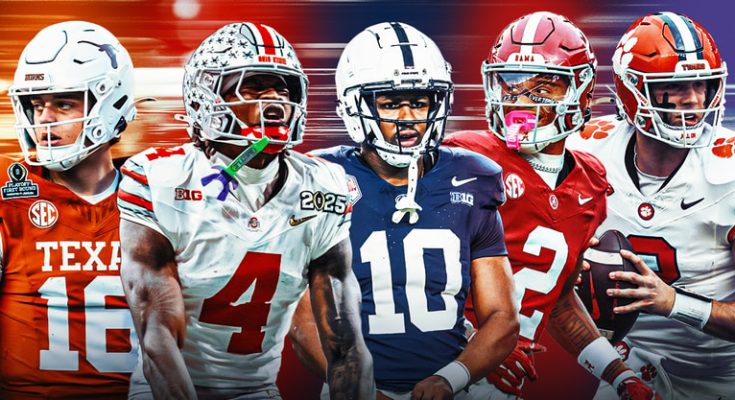Clemson’s 2025 AP Poll Preseason Ranking and What It Reflects About Their College Football Outlook
As the 2025 college football season approached, anticipation was high for many powerhouse programs across the nation, and Clemson University was no exception. Known for its rich football tradition, consistent competitiveness, and passionate fan base, Clemson’s position in the Associated Press (AP) preseason poll was a subject of intense discussion. The AP poll, a staple in college football, provides an early snapshot of how experts, sportswriters, and broadcasters view the upcoming season’s contenders. It sets expectations, influences media narratives, and often serves as a psychological benchmark for teams.
For the 2025 season, Clemson began ranked at number 12 in the AP preseason poll. This ranking was particularly notable considering Clemson’s historical presence near the top of the rankings in previous years, where they frequently landed in the top five or even within the top three spots. The number 12 preseason placement reflected a period of transition and recalibration for the Tigers after several seasons marked by coaching changes, player turnover, and stiff competition in the Atlantic Coast Conference (ACC) and nationally. While still respected as a formidable program, the slightly lower preseason ranking indicated that many analysts viewed Clemson as a team with potential but also some uncertainty.
This placement at number 12 can be better understood by looking at a few key factors. First, the departure of key players from the 2024 roster due to graduation or the NFL draft significantly influenced perceptions. Clemson, like many top programs, regularly produces NFL-caliber talent, and losing such athletes inevitably raises questions about depth and experience for the following season. In 2025, the Tigers were navigating the challenge of rebuilding around a younger core of players, including new starters at critical positions such as quarterback, offensive line, and secondary.
Secondly, the coaching staff’s evolution played a role. The 2025 season was only the second or third year under a relatively new head coach, who was still instilling his philosophy and systems. Coaching stability is often a key to maintaining high preseason rankings, and while the Tigers had shown flashes of brilliance, the pollsters seemed to want more consistent evidence that the team had fully adapted to the new leadership.
The ACC’s overall competitiveness also impacted Clemson’s ranking. The conference had seen an influx of talent and the rise of other strong programs, which narrowed the gap and made the Tigers’ path more challenging. Rival teams like Florida State, North Carolina, and Miami had been bolstering their rosters and improving their performances, resulting in a more balanced conference landscape. Poll voters tend to account for this when ranking teams, and Clemson’s spot at number 12 reflected this growing parity.
Another element influencing the preseason poll was the schedule itself. Clemson’s 2025 slate included several difficult matchups, both within the conference and non-conference games. These opponents were ranked highly or were traditionally tough teams, making Clemson’s path to a top-tier ranking more precarious in the eyes of voters. Strength of schedule is a critical factor in preseason rankings because it anticipates not just the talent on a roster but the likelihood of key wins or losses that shape a team’s season trajectory.
Despite the challenges suggested by the number 12 ranking, the Tigers’ position still signaled respect for the program’s enduring qualities. Clemson’s recruiting pipeline remained strong, with highly regarded freshmen expected to make immediate impacts. The program’s ability to develop players and compete at a high level was not in doubt, and many analysts believed that Clemson had the tools to exceed expectations as the season unfolded.
Historically, preseason AP poll rankings are both an honor and a source of motivation for teams. Being ranked in the top 25 sets a standard but also draws attention from opponents eager to knock a ranked team off its pedestal. For Clemson in 2025, starting the season at number 12 was a signal that while they might not have been the overwhelming favorites, they were certainly a major player with the potential to disrupt predictions and climb higher with strong performances.
In addition to reflecting current conditions, preseason rankings like Clemson’s number 12 spot also impact recruitment, fan engagement, and media coverage. Prospective players look at these rankings as indicators of a program’s health and visibility, while fans gauge their expectations and excitement for the season. Media outlets use the poll to frame storylines, debate contenders, and generate narratives that carry throughout the college football calendar.
Ultimately, Clemson’s preseason AP ranking of 12 for the 2025 season was a nuanced reflection of a storied program in transition, poised between past dominance and future potential. It acknowledged the Tigers’ challenges while affirming their status as a significant contender. As the season progressed, Clemson’s ability to leverage talent, coaching, and resilience would determine if they could surpass this initial ranking and reassert themselves among the elite teams in college football.
In summary, Clemson entered the 2025 college football season ranked 12th in the AP preseason poll, a placement that embodied both the respect for their historical excellence and the recognition of the hurdles ahead. This ranking served as a starting point for the Tigers’ journey, encapsulating the complexities of team dynamics, coaching, competition, and expectations that define college football’s ever-evolving landscape.



